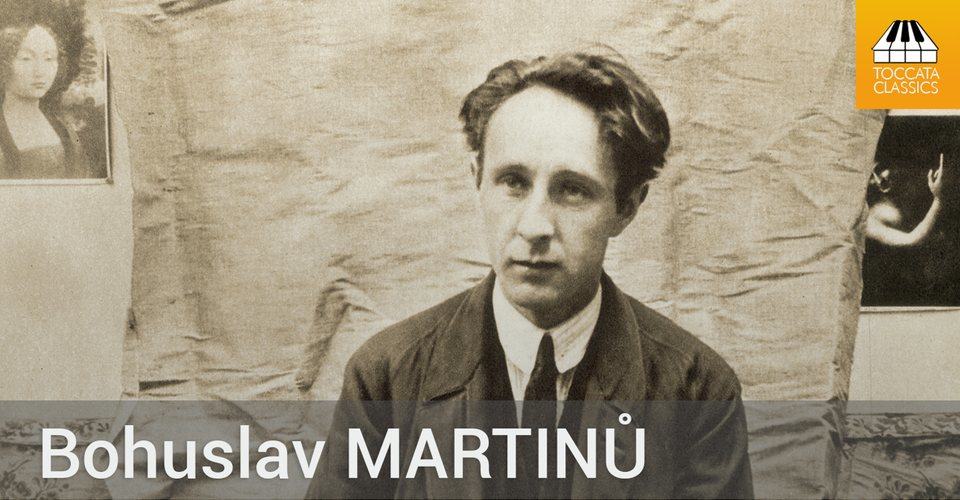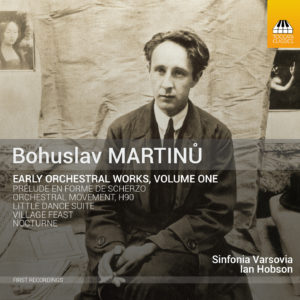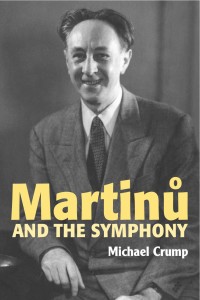In April 2013, Toccata Classics released a recording entitled Bohuslav Martinů – Early Orchestral Works, Volume 1, launching what is hoped will be a series of six releases in total. I played a large role in the preparation of that first album, and so some time back Martin Anderson of Toccata asked me to write a guest blog about it. I’ve been busy preparing materials for a piece which we hope will be on Volume 3, so my response has been delayed. Nonetheless, my timing for once is pretty good, for two reasons. First of all, the original batch of Volume 1 CDs has now sold out, and the re-issue will feature a new design in the fetching style of more recent Toccata releases. Second, Volume 2 is scheduled to appear in June. My book Martinů and the Symphony was in part the catalyst for this series, and so in this three-part blog I’ll tell you first how the book came to be written, before discussing the two CDs in the later parts.
My first acquaintance with Martinů’s music came in 1983, on a short European tour which I undertook with a student orchestra from Oxford University in the year after I graduated. Before that tour, Martinů had been merely a name to me. It was by sheer chance that I was on this tour at all. One of the pieces had a very demanding piano part, but the pianist originally booked for the tour pulled out at short notice. His place was taken by a very good friend of mine, Stephen Emmerson. Stephen is now a professor of piano at Brisbane Conservatoire, but was originally going on the tour as a viola player. An extra violist was now required, and I filled the gap. And what was the piece with the demanding piano part? It was Martinů’s Oboe Concerto, played wonderfully by the principal oboe of the Oxford University Orchestra, Victoria Trotman.
The tour of Europe took place under the auspices of a festival called ‘Jugend und Musik in Wien’. It attracted young musicians from all over the world to Vienna. There was much variety, and I‘ll never forget hearing a young Chinese ensemble playing Eine kleine Nachtmusik on accordions and cymbals. Or that our orchestra’s rendition of the First Chamber Symphony earned a special prize for the festival’s best performance of a work by Schoenberg (there was only one other Schoenberg performance).
Intrigued by the Martinů concerto, I bought the Supraphon set of Symphonies Nos. 3, 4 and 5 conducted by Václav Neumann when I got back to Oxford (at that time, his Martinů cycle was the only one that was easy to obtain). This music was much consolation to me during the following year at the College of Librarianship, Aberystwyth, where I spent nine months regretting a decision to train as a librarian. Those symphonies were unlike anything I had heard before – by the end of the year I was so enthused with them that I knew I wanted to study them properly. I was indeed fortunate to be accepted as a post-graduate student at Birmingham University and to have the expert guidance of Jan Smaczny for the next two years as I wrote my M. Litt thesis on the Martinů symphonies.
The thesis was completed in the summer of 1986, and I pondered what to do next. I have come to realise that whenever I have thoughts of an academic career, a severe economic recession instantly develops. I had wanted to stay on at Birmingham in a junior academic post and to extend my Master’s thesis into a doctoral thesis. That proved impossible. The job – which was initially just a one-year contract – went to someone who already had a doctorate and who had reached what I then thought of as the grand old age of 40. There was one industry at the time which seemed immune to the worsening economic situation – that was the emerging computer industry. I had always been adamant that I would never work in computing but somehow spent the next sixteen years in Birmingham doing precisely that.
It was just after I obtained my first such job in 1986 that I initially heard from Martin Anderson. He had established Toccata Press by then but was still working for the OECD in Paris if I remember correctly [he does –MA]. He was hoping to commission a book on Martinů, to be written jointly by Jan Smaczny and me, but neither of us felt able to undertake such a project at the time. Nonetheless, this episode shows you that the Toccata commitment to Martinů goes back a long way.
Over the following years, I occasionally thought of extracting an article from the thesis and sending it to a periodical. I did get as far as writing a draft, but never progressed further with the idea. By 1993, I would have been hard pressed to give you a summary of what I had written in the thesis – it really seemed to belong to the remote past – but in that year, while in the wonderful music section of Birmingham Central Library, I spotted some leaflets promoting The Dvořák Society of Great Britain. I duly joined the Society and with them paid my first visits to the Czech Republic (don’t forget that my studies predated the Velvet Revolution – I had tried to visit what was then Czechoslovakia during my two years of study, but it proved impossible). On our third visit, in 1999, Society members were invited to the Martinů Institute. I was keen to go, and while there, my interest was taken by their large collection of academic theses on the composer. There was, nonetheless, at least one thesis that had eluded them. I intensely dislike self-promotion, and so only as we were leaving did I decide, with some embarrassment, to tell Sandra Bergmannová, who had shown us around, that I had also written on Martinů. She asked me to send a copy of the thesis to the Institute, which I soon did. Aleš Březina, the director of the Martinů Institute, read it and encouraged me to publish it, giving me some publisher details that looked rather familiar – Martin Anderson of Toccata Press.
Martin and I met up in London in August 2000, and this time I accepted the challenge. I felt it would take about two years to adapt my thesis for a wider readership. It became apparent that my estimating skills were rather poor by the time the book finally came out in 2010 – but my commitment to writing it helped me make some tough decisions in the intervening years. Soon after starting the work, it became obvious I could not progress very far while holding down a full-time job. My employer, TNT in Atherstone, was very gracious in allowing me to go part-time, three days a week. There still wasn’t enough time; after six months I had merely overhauled the original Chapter 1. So the big decision was taken – I left my job (with reluctance) and moved back to my home town of Ebbw Vale in Wales. The disparity in property prices left me with enough money after the transaction to forget about employment and simply write the book over the next eighteen months or so. At the end of that time I took the draft of the book to Aleš Březina in Prague – a real turning point in the tale.
I had adapted the nine chapters of my thesis, taking out the extremely boring sections, of which there were many. I had added a short biographical chapter at the beginning, and asked Aleš to read it. I knew that if any factual inaccuracies had crept in, he would spot them. He didn’t find any. Instead, to my utter dismay, he said that the chapter was ‘a lazy nineteenth-century-style biography’ and that he could not understand why I had not given an account of Martinů’s orchestral music up to the writing of the First Symphony in 1941.
It is fair to say that if Aleš had been more diplomatic and less candid, the Martinů Early Orchestral Works project would not exist. At first I felt like Sisyphus. I’d been rolling this stone up a steep hill for some years already. With the summit in sight, the boulder had slipped from my grasp. In truth, I felt jealous of Sisyphus – he was condemned merely to do the same thing again, whereas I had a completely new task ahead of me – not only to locate scores of the earlier orchestral works and analyse them, but to seek out the manuscripts of the many unpublished and unperformed orchestral works which litter Martinů’s early career. I had just started retraining as a tutor of literacy and numeracy to adults, and did not feel inclined to meet this new challenge. I didn’t realise that the most absorbing and rewarding tasks needed to complete the book were still ahead of me. Publishers proved to be very supportive in providing scores of works like La Rhapsodie or Inventions and with the help of staff at the Martinů Institute and the Martinů Centre in Polička I was able to examine the much more obscure works which had remained in manuscript – such as the early symphonic poem The Death of Tintagiles, the ballets Night and The Shadow, and a strange impressionist piece without title.
Although I had been exploring Martinů’s music for over twenty years, these early unpublished works consistently surprised me with their quality and imagination. It took Martinů a long time to develop the highly distinctive style which so captivated me in the mid-1980s, and these works on the whole give little clue of what he would become. Once in a while, one spots the emergence of a trend that Martinů would develop more fully in later years – for instance, the tritonal obsession of Tintagiles, the use of the piano in a chamber setting for The Shadow, or the fashioning of a lengthy melodic line from a few basic elements in the untitled piece. This music, largely ignored or dismissed since it was written, was far better than I had expected it to be. Consequently, I wrote about it at length in the first chapter of the book, arguing the case for exhumation of these buried treasures. I hoped that I hadn’t exhausted the reader’s patience by writing so much about ‘works unlikely to be seen in print or heard in performance’. I certainly did not suspect that I would be playing a part in getting them seen and heard, but I reckoned without the tenacity of Martin Anderson. In the next part of this blog, I’ll introduce the third member of our Martinů triumvirate and describe how we liberated some of these pieces from their incarceration in the footnotes of Martinů biographies.


